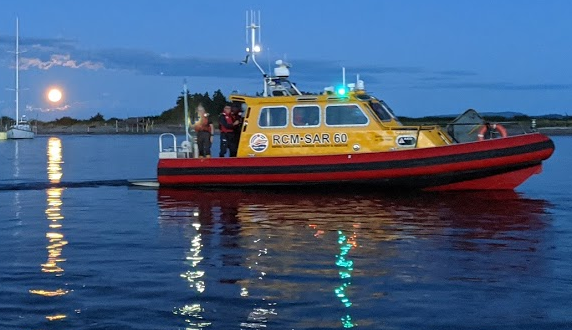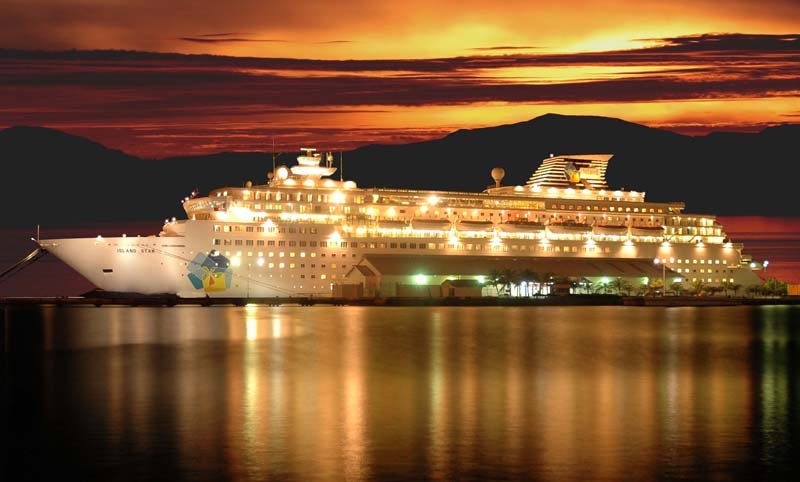Lights and Shapes in the Real World
 A schematic for lights and shapes on this web site and on many other web sites and apps often make it seem simple to see a particular combination. So it seems like the main challenge is to remember what sort of vessel the configuration means. However, once you are on the water, it may not be all that simple. Often it is difficult to discern the lights you seeing.
A schematic for lights and shapes on this web site and on many other web sites and apps often make it seem simple to see a particular combination. So it seems like the main challenge is to remember what sort of vessel the configuration means. However, once you are on the water, it may not be all that simple. Often it is difficult to discern the lights you seeing.
This image is of CAPE LAZO in the early evening showing appropriate lights, namely a green side light (for the starboard side) and a white all-round light (combination white masthead light and stern light). A member of the crew on the aft deck has a flashlight; this shows up best in the reflection on the water's surface. On the left side of the photo is the moon just above the horizon, with its own reflection on the water's surface.
 In a schematic for the navigation lights for CAPE LAZO, this would be shown something like the image on the right. This representation has left out some of the possible confusion from other sources of light.
In a schematic for the navigation lights for CAPE LAZO, this would be shown something like the image on the right. This representation has left out some of the possible confusion from other sources of light.
 For another example, see the image of the SEASPAN QUEEN, a local tugboat, in the early evening moving right to left and showing her port side. This shows how it can be difficult to pick out the meaningful lights from less meaningful ones.
For another example, see the image of the SEASPAN QUEEN, a local tugboat, in the early evening moving right to left and showing her port side. This shows how it can be difficult to pick out the meaningful lights from less meaningful ones.
SEASPAN QUEEN has three masthead lights mounted vertically indicating she has a tow of greater than 200m. She is also showing the port side light (red), just above the wheelhouse. There also appears to be another white light amidships at the level of the main deck. Upon close inspection it is clear that this light comes from an open door to the interior of the deckhouse; it should not be confused with a navigation light.
 In a schematic, the light pattern for SEASPAN QUEEN would be shown as in the diagram. Of course the light shining out the door in the deck house is not shown.
In a schematic, the light pattern for SEASPAN QUEEN would be shown as in the diagram. Of course the light shining out the door in the deck house is not shown.
The point is that having memorized the light combinations may not be enough. Once you are on the water and you see some lights, you might have to spend a few moments excluding irrelevant lights in order to select those that matter for the purposes of the COLREGS.
 There is a direction within the COLREGS that "no other lights shall be exhibited, except such lights as cannot be mistaken for the lights specified" elsewhere in the Rules (Rule 20(b)). This means that prudent mariners will not show lights that might confuse a viewer. However, additional illumination is often required when on the water at night. This can make it difficult to always comply with using only illumination that "cannot be mistaken" for some combination that may be required. It is impossible to pick out the navigation lights of this cruise ship; but, at least, you are not likely to mistake it for anything else!
There is a direction within the COLREGS that "no other lights shall be exhibited, except such lights as cannot be mistaken for the lights specified" elsewhere in the Rules (Rule 20(b)). This means that prudent mariners will not show lights that might confuse a viewer. However, additional illumination is often required when on the water at night. This can make it difficult to always comply with using only illumination that "cannot be mistaken" for some combination that may be required. It is impossible to pick out the navigation lights of this cruise ship; but, at least, you are not likely to mistake it for anything else!